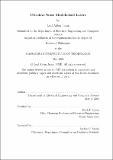Ultralow-noise modelocked lasers
Author(s)
Jiang, Leaf Alden, 1976-
DownloadFull printable version (6.369Mb)
Other Contributors
Massachusetts Institute of Technology. Dept. of Electrical Engineering and Computer Science.
Advisor
Erich P. Ippen.
Terms of use
Metadata
Show full item recordAbstract
The measurement, design, and theory of ultralow-noise actively modelocked lasers are presented. We demonstrate quantum-limited noise performance of a hybridly modelocked semiconductor laser with an rms timing jitter of only 47 fs (10 Hz to 10 MHz) and 86 fs (10 Hz to 4.5 GHz). The daunting task of measuring ultralow-noise levels is solved by a combined use of microwave and optical measurement techniques that yield complete characterization of the laser noise from DC to half the laser repetition rate. Optical cross-correlation techniques are shown to be a useful tool for quantifying fast noise processes, isolating the timing jitter noise component, measuring timing jitter asymmetries, and measuring correlations of pulses in harmonically modelocked lasers. A noise model for harmonically modelocked lasers is presented that illustrates how to correctly interpret the amplitude noise and timing jitter from microwave measurements. Using information about the supermodes, the amplitude and timing noise can be quantified independently, thereby making it possible to measure the noise of harmonically modelocked lasers with multi-gigahertz repetition rates. Methods to further reduce the noise of a modelocked laser are explored. We demonstrate that photon seeding is effective at reducing the noise of a modelocked semiconductor laser without increasing the pulse width. Experimental demonstrations of a timing jitter eater, consisting of a phase modulator and dispersive fiber, show that. (cont.) An analytical theory for semiconductor lasers that includes carrier dynamics is presented. Ultralow noise performance is achieved by reducing the dispersion of the cavity, reducing the linear losses in the cavity, by operating at high optical powers, and with a tight optical filter. The gain dynamics of the semiconductor laser do not severely degrade the noise performance.
Description
Thesis (Ph. D.)--Massachusetts Institute of Technology, Dept. of Electrical Engineering and Computer Science, 2002. Includes bibliographical references (p. 343-357). This electronic version was submitted by the student author. The certified thesis is available in the Institute Archives and Special Collections.
Date issued
2002Department
Massachusetts Institute of Technology. Department of Electrical Engineering and Computer SciencePublisher
Massachusetts Institute of Technology
Keywords
Electrical Engineering and Computer Science.